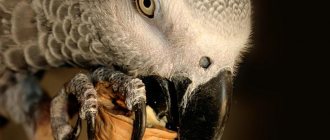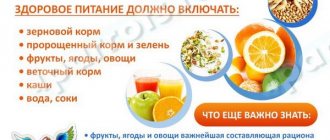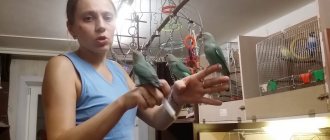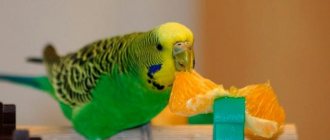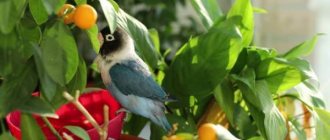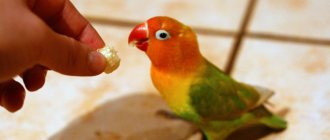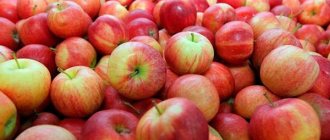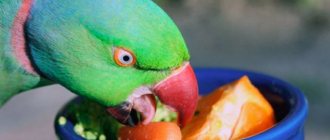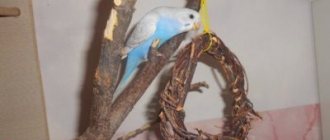Can budgies be given cabbage and why?
Many feathered pet owners wonder whether parrots can eat cabbage. Of course, it should be included in the diet. The white cabbage variety is given by finely chopping it. It is endowed with a large amount of minerals, vitamins and fiber. All this is important for the pet’s well-being.
It is cabbage in winter that is one of the easily accessible vegetables that benefits the parrot. It is best to give your parrot cabbage from your own garden, that is, not treated with chemicals that are harmful to the bird's stomach. Therefore, if possible, prefer home harvest. This also applies to other vegetables, fruits and herbs that are allowed to be given to the parrot. They form an integral part of a regular diet.
Breeders with solid experience notice that their pets are delighted with carrots, rich in carotene, calcium and iron. It is best to grate it using a grater or cut it into small pieces. Some owners treat their parrots to carrots mixed with a boiled chicken egg or cottage cheese. Carrots also go well with zucchini, which is rich in fiber and vitamin B. The vegetable diet of feathered pets includes pumpkin, which contains a lot of sugars and beneficial elements that have a positive effect on the bird’s tone.
It is better not to give Chinese cabbage. Cauliflower can also be included in the category of prohibited vegetables. These varieties will not benefit the bird. It is better to serve any permitted vegetables in chopped form. Cucumbers are legal for parrots and include vitamin E and potassium. Brussels sprouts are also allowed. But it’s better not to pamper your pet with vegetables from the greenhouse; they can be oversaturated with nitrates, which will not benefit the bird’s body. This also applies to tomatoes grown in a greenhouse. Parrots like sweet bell peppers, but they should never give them spicy peppers.
For parrots, eggplants, celery, radishes, and garlic are prohibited; it is better not to overuse broccoli. But you can give red cabbage. The owner of a parrot should always take into account the personal preferences of the ward. If he doesn’t want to eat any of the allowed vegetables, it still won’t be possible to force him. Better try to choose an alternative vegetable.
Before you figure out whether cabbage can be given to your budgie, remember the principles of keeping and caring for your feathered pet. You need to choose a house yourself and equip it with everything you need in advance, before the parrot appears in the house. Think in advance where the cage will be located, what entertainment and toys to hang in it. Make sure the doors in the cage are locked, because smart parrots will eventually learn to open them with their beaks and get out for a walk. Such carelessness will one day lead to the pet simply flying out of the window or being injured.
Side effects of eating beets
Cooking and feeding beets to your parrot can be a bit of a mess. This means that from the moment you get them ready to feed, the house can be very messy! It's probably best to make sure you don't have anything that could go bad around your parrot while he's eating the beets. Also make sure that when preparing them you understand that your hands will get a little dirty too.
Don't be alarmed if your parrots' poop is also slightly pink and stains everything it touches. This is part and parcel of your parrot eating beets, so rest assured that everything is fine!
Food of plant origin
We talked about the main plant food (grain mixture) in the article “Food for a budgie.” However, grain is not the only plant product that is given to these pets. For example, you can cook porridge with it. This is an excellent supplemental food that can be included in a bird's daily diet.
Suitable cereals for cooking include peas, beans, millet, oatmeal, buckwheat, rice and others. To cook porridge correctly, you must follow two rules:
Porridge
Porridge for parrots is also very healthy. This is not only a source of many microelements, but also a means that will help birds normalize their metabolism if it is disturbed. Cook porridge only in water, without adding sugar or salt.
You can cook complex mixtures consisting of several cereals, as well as mono-porridge for budgies from buckwheat, oatmeal, and brown rice. You can add legumes, as well as grated fruits or vegetables to the porridge. The finished cereal can be cooked viscous or crumbly. In this case, listen to the food tastes of your pet.
You can store the cooked porridge in the refrigerator for no more than 2 days.
How to give cabbage to a parrot
Cabbage is given to the bird daily as an addition to the main menu, i.e. three times a day. It should be given in small quantities and always in crushed form. Regular (white cabbage) is introduced into the diet fresh or after treatment with boiling water to make it softer.
You can give both leaves and stalks. It is advisable to grate it. Beijing, cauliflower and kohlrabi must be blanched (immerse in boiling water for 2 minutes and rinse with cold water). Broccoli also needs to be treated with boiling water.
Vegetables must be given to the bird, since it cannot get all the necessary substances from grain feed. White cabbage is the best source of nutrients.
Can budgies have cabbage and pumpkins or how to properly feed your feathered friend
Buying a parrot is only half the battle. Its maintenance, proper feeding and hygiene care are the main tasks for the owner. Usually such a friend is purchased for children. This helps the child develop and instills respect and responsibility. But the main role of the owner still remains with the parents. Even a baby can learn to talk, which is just right for a bird, because a soft and clear voice is needed. And then the little pet will really learn to talk and sing. Children cannot be trusted to feed that food. And not at all because they will not be able to pour grain, but only because of overfeeding. You should also know which vegetables and fruits are allowed and prohibited. Can budgies eat cabbage or pumpkin, apple or peach? You should know all this before purchasing a bird and warn everyone who is near the bird.
Proper care and feeding
Before we begin to figure out whether budgies can eat fresh pumpkin, and what varieties, it is worth understanding the principle of feeding and care. You need to independently select a cage and arrange it before acquiring a new tenant. Immediately decide where it will stand and what toys the pet needs. So, for example, you should choose a cage that is spacious and made of good material. Immediately fix the doors in it. Parrots are very cunning and dexterous, despite their small appearance. With their beak they open any unsecured opening and go outside for a walk. Such a mistake leads to the fact that the feathered friend flies through the window or is injured. Without knowing that the bird is flying around the house, it can be crushed by doors and even stepped on.
A parrot's home should be convenient and comfortable
The next stage is arranging the nest. It is the new home that should become a safe place for the parrot. If you plan to let him out to walk around the house, then this fact does not negate the improvement of the cage. It must be:
- two perches;
- mirror (if one individual);
- feeder and sippy cup;
- the lower part is removable for better cleaning;
- ladder and ring.
If there are no such things, then in the absence of people the parrot gets bored and because of this, many problems and misunderstandings occur. For example, a bird stops talking, eating, and gets sick.
There should be light around the cage, but without drafts. Keep night lights nearby. This species of birds dreams, and quite often nightmares. This leads to stress. In the dark, the fidget will not understand where to be and will break its wings or neck. When the light is on, such problems do not arise.
Most often, dry food is purchased, a ready-made mixture of several grains.
Feeding must comply with the rules and regulations. As a rule, you buy dry food, a ready-made mixture of several grains. This mixture can be given no more than 2 tsp per day. During pregnancy and active development (from two months to 6 months) it can be increased. But the diet is usually supplemented with fresh fruits and vegetables. Otherwise, by overfeeding your pet, there is a risk of being left without it or causing problems in the digestive system. In birds it is very well developed, and all food is digested quickly. Therefore, it is worth giving food gradually: in the morning, afternoon and evening. It is not recommended to give the entire daily requirement.
Need to know! Provided that the owner will be absent for more than 8 hours, the bird cannot be left with the daily allowance. He will quickly eat everything and spend the rest of the day hungry. From hunger, birds begin to get sick, suffer from digestive problems, and death is possible.
There is one more feature of feeding: the feeder is renewed every time. More precisely, the remains, if any, are poured out, and a new portion is poured. This is due to the fact that the bird does not control the passage of urine and feces. There may be excrement in the food that is harmful to the bird.
Fruit menu
Introduce fresh, dried and dried fruits into your parrot's menu. But keep in mind that it is better to make the preparations yourself. When eaten, the bird will not only receive pleasure, but also the necessary content of vitamins and minerals that are necessary daily for the good functioning of the body. Each fruit contains a different amount of useful components. When feeding fruit treats, follow the norm.
Many owners ask various questions: can budgies eat tangerines or kiwis, and what fruits to feed and which not. Let's begin to clarify these issues.
Here are the fruits you can give your budgies:
- Bananas are very nutritious, rich in calcium, magnesium and potassium. Content of fiber, all kinds of useful acids. A couple of pieces a day will be enough to maintain and saturate the body with essential vitamins;
- Apple is a vitamin cocktail, enzymes that are good for the digestive tract. Contains tannins, plant fibers and organic acids. The norm need not be limited;
- pomegranate is very necessary, its substances ensure the functioning of the cardiovascular system. A few grains a day, but introduce them gradually, starting with a minimum amount. The norm per day is no more than 1/6 part;
- kiwi – strengthens the parrot’s immunity. The fruits are leaders in vitamin C content. Protects the body from viruses;
- pears - for digestion, which is promoted by pectin. The composition contains carbohydrates, iron, phosphorus. Peel the skin first. Give in any quantity;
- orange – contains fiber, essential oils, carbohydrates. Well protects the body from viral and infectious diseases. A small piece a day. Also add other citrus fruits to the menu. Dilute lemon juice with water;
- grapes are rich in microelements and vitamins. Give 2 - 3 berries without skin, there is no need to remove the seeds. Cleanses the body and removes toxins;
- pineapple - the composition has a positive effect on muscle tissue and strengthens blood vessels. Has general strengthening properties. Destroys proteins, helps digest and absorb protein foods.
- apricot is the owner of sugar, inulin, starch, provitamin A, iron, acid. Supports the immune system, prevents cardiovascular diseases;
Persimmon, mango, papaya, avocado - these exotic fruits are not recommended to be given to your pet.
Important! Add a variety of edible berries, fresh or frozen, to your diet. You can prepare it yourself in the summer. The treat must be fresh and well washed, otherwise it will lead to serious illness and death.
All fruits should be peeled and cut into pieces. Remove the seeds, which are dangerous because they contain hydrocyanic acid. It is recommended to feed with vitamins from your garden, so-called natural products. Store-bought fruits often contain an abundance of nitrates and other substances that are detrimental to the health of the parrot.
Allowed vegetables and fruits
Only dry food is unacceptable. Even if it contains all the necessary vitamins and microelements, you should add fresh vegetables and fruits daily. Grass is a must. They buy it at a pet store. Cultivation does not take time or labor. This makes up for the deficiency of all substances.
Pets must receive the required amount of vitamins
The permitted and mandatory ones are:
It is better to avoid rice and buckwheat. It is recommended to prepare multi-grain porridge. Cook in small portions without adding spices, sugar or oil
Nuts and persimmons are prohibited. They should absolutely not be given. Lilies of the valley, heather and begonias, ficus and tulips will be poisonous to birds. No bell peppers or potatoes. Spices and sweets are especially dangerous. They provide the basis for the appearance of helminthic infestations, which are difficult to remove on your own (like most diseases).
Hard food
The daily diet of parrots should include a grain composition. This is the basis without which it is difficult to imagine proper nutrition. When to pour food into the feeder (the daily norm once a day or add food several times a day) does not really matter, the main thing is that the parrot always has enough food, since they can do without food for no more than 24 hours.
Pet stores offer a wide selection of grain mixtures, ranging from the diet of budgerigars to large birds. Feed compositions vary depending on the size of the pet and its natural habitat. The following brands have proven themselves well: Italian Padovan, Belgian Versele-Laga, Italian Fiory, Russian RIO. When purchasing, be sure to make sure that the grain feed is tightly packaged and that its expiration date has not expired. Before pouring it into the bird's feeder, carefully inspect the grain to ensure there are no foreign impurities in it.
The nutrition of budgerigars or other species of these birds can be diversified by germinating the grain mixture. Sprouts are a storehouse of vitamins for parrots, which will have a beneficial effect on the functioning of your pet’s entire body. Please note that if you do not wait for the greenery to fully germinate (to the point of grass), but give a slightly hatching sprout, then such feeding provokes sexual behavior in birds. In addition to very young shoots, the bird also needs ordinary greens (nettle, lettuce, fireweed, dandelion). Greens from oats, wheat, and lettuce can also be grown on your windowsill.
When feeding Grays or other large birds, keep in mind that mixtures for large parrots already include nuts and seeds, so you should not offer them separately; use them separately only as a reward or treat.
As for pumpkin and cabbage
Given the conditions of home maintenance and the availability of real vitamins, which in our time are quite expensive, it is worth discussing two fruits that are easiest to get in the winter. You can’t call them expensive either: pumpkin and cabbage.
Can budgies eat cabbage? It depends on what variety. If it comes to white cabbage, then it’s quite suitable. It will become the basis for replenishing microelements and vitamins. Cabbage is very rich in them. Give finely chopped and in small portions. It contains fiber. And this is important for a parrot. It is better not to give Chinese cabbage or cauliflower. These types of food will not bring any benefit to the bird.
Vegetables you can give your parrot
Tomato
Tomato is also a good type of food that contains carotene. Tomatoes do not have any side effects on the parrot's body. The parrot is fed only fresh; parrots give special preference to seeds.
Cabbage
Cabbage is also a good food for parrots, which contains a large amount of microelements. Cabbage is valuable for its abundance and long-term storage. This is one of the main food for parrots in winter. It is necessary to feed cabbage to the parrot raw, giving only the leaves whole. The stalk should be finely chopped or grated.
Carrot
Carrots are a particularly valuable food for parrots, containing carotene and many other useful substances. Carrots should be fed only raw, first cut into small pieces or grated. It is recommended to mix with other ingredients, such as boiled eggs, breadcrumbs, etc.
Cucumber
Cucumbers can be included in a parrot's diet, but they are not of great importance. They are consumed only fresh as food containing vitamins and microelements.
Pepper
Bell pepper contains vitamin C. When raw, cut into large pieces and feed to the parrot.
Potato
Potatoes contain a lot of starch, but few vitamins and microelements. You can feed your parrot either raw or boiled, and should be given in small portions. You should not give your parrot tubers that have sprouted or turned green. They contain a substance that is poisonous to parrots - solanine, which can cause poisoning in a parrot.
Pumpkin
Pumpkin also contains carotene, similar to previous fruits. Feed pumpkin raw. Pumpkin seeds have a mild anthelmintic effect.
Beets, turnips, onions, lettuce, spinach
All of these vegetables are also suitable for adding to a parrot's diet. Beets, like cabbage, are valuable for long-term storage. This vitamin food can be fed fresh to the parrot in winter. Onions - mild varieties should be used. In winter, you can sprout onions and give greens in small quantities. Turnips are fed to the parrot in the same way as cabbage; it must be finely chopped or grated. Spinach or lettuce should be given in small quantities. May cause minor digestive upset if taken in large doses in the diet. Do not give the parrot wilted or wet stems; they must be dried.
Wild grass, grass seeds
Weeds are also suitable for consumption, especially during the seed ripening period. For example, parrots willingly eat dandelion baskets. You can also make herbal flour from weeds. Let's take nettle, you need to cut off the upper third of the stem with leaves during flowering, tie the cut stems into a bunch and dry until completely dry. After this, put the bunches in a bowl and crush, the flour is ready. Pour hot water over this flour, strain through a sieve or cheesecloth and add to any liquid mixture for the parrot. You can also use this flour in dry form, you need to sprinkle it with grated boiled egg or soaked bread.
Greens in the diet
Greens must be present in the diet, no less than vegetables or fruits.
Make sure that your greens are thoroughly washed under running water. Like vegetables, greens should come from your own garden or rural ecological area, and in no case from the city.
- meadow grass
- burdock (burdock)
- branches of various thicknesses of fruit trees with buds, with young green leaves
- grapevine
- greens of cereal crops: oats, wheat, etc.
- woodlice
- carrot and beet tops
- knotweed
- leaf salads
- nettle leaves scalded with boiling water
- quinoa and spinach in limited quantities
- clover
- plantain leaves
